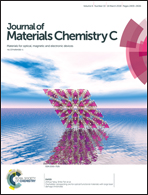Synthesis and characterization of porphyrin–DNA constructs for the self-assembly of modular energy transfer arrays†
Abstract
In this report, a 5′ azide-terminated single-stranded DNA (ssDNA) was covalently attached to a Zn-tetra(phenylethynyl)porphyrin (ZnTPEP) utilizing copper(I) catalyzed azide–alkyne cycloaddition (CuAAC) to form five DNA–porphyrin adducts containing one to four ssDNAs attached around the porphyrin core. The newly synthesized DNA–porphyrin adducts provide a modular platform that allows us to assemble donor–acceptor energy transfer (EnT) arrays/constructs using complementary dye-labeled ssDNAs, herein a 3′ AlexaFluor 546 (A546)-labeled ssDNA, with different donor : acceptor ratios. The photophysical properties of the DNA–porphyrin constructs, along with the individual donor and acceptor fluorophores, were investigated by electronic absorption and steady-state emission spectroscopy. The data shows that A546 (donor) emission spectrum is significantly quenched in each of the constructs with EnT efficiencies that are comparable to the predicted EnT determined through modeling the Förster resonance energy transfer (FRET) mechanism.



 Please wait while we load your content...
Please wait while we load your content...